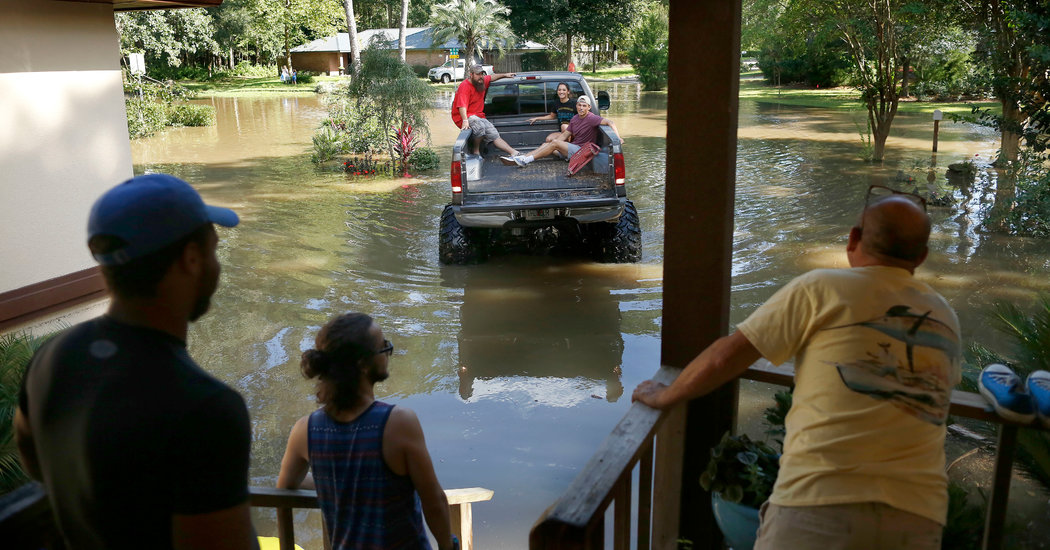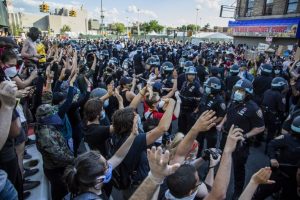GAINESVILLE, Fla. — In 2016, the torrential rains unleashed by Hurricane Matthew flooded my bathroom. Hurricane Irma demolished part of our coastline in 2017, leaving a litter of gutted restaurants in its wake. After Hurricane Michael in 2018, our small airport in the central part of the state transformed into a hub for private pilots to fly supplies into ravaged areas of the panhandle.
It’s the same every year: Water gushes through the streets, pooling three feet deep in some places. People mill about on sidewalks on higher ground, surveying the fallen tree branches and crackling electrical lines. Work crew trucks idle as people in hard hats try to restore power. Cars try to negotiate the floods but their engines, clogged with swamp water, inevitably sputter out. Seasoned locals have learned to adapt to whatever Mother Nature throws at us, and rebuild when the waters recede.
While hurricane season doesn’t officially start until June 1, last week tropical storm Bertha brought more than a foot of rain in three days to Miami, triggering widespread street flooding. A storm brewing in the Atlantic Ocean could next become the third earliest tropical storm on record. With the National Oceanic and Atmospheric Administration forecasting an above average hurricane season, this year Floridians will have to weigh what is more dangerous — a storm or the coronavirus.
When deciding which course of action to take, people in a hurricane’s path will consider the storm’s intensity. Is it strong enough to knock out the power? Is there enough time to leave town before the roads are closed?
Here in Gainesville, when an evacuation order is issued we flock to the back roads or the interstate highways that flow north. Others drive to Atlanta and cram into the city’s hotels. Some open their homes, businesses and neighborhoods to people fleeing from the storms projected to hit the state’s southern coasts.
Now, we must also weigh those factors against the risk of potentially contracting the coronavirus and spreading it to others. Should we stay home and in the path of a storm that could potentially demolish it, or shelter in a building crammed with people who could be carrying the virus that has killed hundreds of thousands of people? Even the Centers for Disease Control and Prevention admit this is a tough prediction game. How will our elder neighbors fare in a shelter that is not equipped to isolate or treat those who could fall ill with Covid-19?
This year, we can expect longer power outages and fewer supplies. Further, with buses having fewer seats in order to keep evacuees a safe distance apart, those who wait too long may have no choice but to ride out the storm at home. How can people who opt to stay at home adequately prepare? How long can they survive, without power, with only the food, water and toiletries on hand?
The Federal Emergency Management Agency is recommending that along with the usual hurricane stockpile, we add two face masks per person and plenty of hand sanitizer. Which, as we all know, isn’t exactly readily available. In the wake of the coronavirus, grocery stores have struggled to keep up with the demand for everything from water, and toilet paper to bread and eggs. An extra hit on the supply chain could break it just when we need it most.
While we need to start preparing now for the season’s coming storms, we must be careful not to do it all at once. We should shop and stock, but slowly. We can begin by obtaining one flashlight at a time. We can fill containers with water and store them in a cool place, instead of buying troughs of bottled fare. If you get the urge to hoard toilet paper, think of your neighbors. Will anyone need some that you can spare while keeping enough for your family? Buy or save your napkins, tissues and other paper goods. Better yet, practice using washcloths or other multiple-use fabrics and washing them.
Get your hurricane shutters now, if you don’t have them. If necessary, you can buy two-by-fours or plywood to make your own. Measure your windows first and have someone at a supply store cut the wood to size, so you can batten them to the outside of the house over your windows. You’ll want to enforce your home structure, but only buy what you need so that there are materials left for others.
We’re operating on George Bailey’s building-and-loan system this year, where people only draw out the amount of supply they need, and share the rest with our neighbors. Sure, the U.S. has increasingly become a me-first world, where capitalism drives us to look out for only our own. But we must put the needs of society on par with those of our families.
The state’s health care system, already strained under the weight of a global pandemic, could splinter should we get a bad storm. The only way to minimize damages is to be prepared. That’s why I’m urging all of us to start planning right now — in excruciating detail — how and when to stock up, and how to protect our most vulnerable populations.
Darlena Cunha (@parentwin) is a freelance journalist and an adjunct professor at the University of Florida.
The Times is committed to publishing a diversity of letters to the editor. We’d like to hear what you think about this or any of our articles. Here are some tips. And here’s our email: [email protected].
Follow The New York Times Opinion section on Facebook, Twitter (@NYTopinion) and Instagram.



















